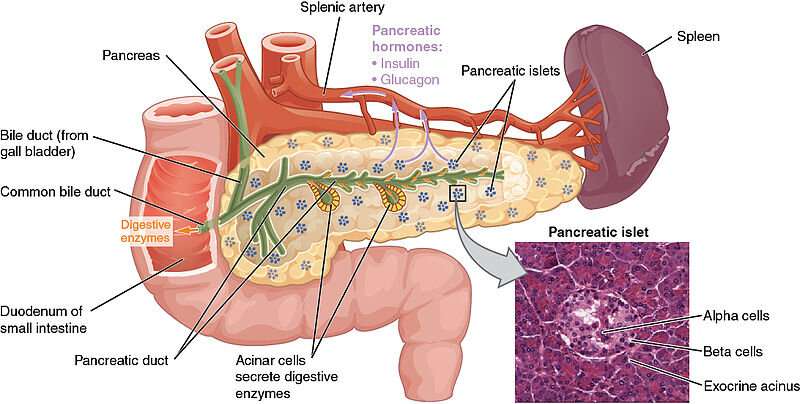This article has been reviewed according to Science X's editorial process and policies. Editors have highlighted the following attributes while ensuring the content's credibility:
fact-checked
peer-reviewed publication
trusted source
proofread
Pancreatic lesions may occur more frequently than previously thought

Pancreatic intraepithelial neoplasia (PanIN) lesions were detected in a majority of healthy pancreases from deceased donors of diverse age and harbored features of pancreatic cancer, according to a study published in Cancer Discovery.
Pancreatic cancer is a rare but highly fatal disease, with a five-year relative survival rate of 11.5%. With few early symptoms, it is typically diagnosed at advanced stages when it is more difficult to treat. Pancreatic cancer may be preceded by several precancer lesions, including PanINs, intraductal papillary mucinous neoplasms, and mucinous cystic neoplasms.
"Understanding how pancreatic tissue evolves as it transitions from normal to precancerous to cancerous will be key to identifying strategies for early detection, prevention, and treatment of pancreatic cancer," said Marina Pasca di Magliano, Ph.D., one of the co-corresponding authors of the study, a researcher at the Rogel Cancer Center, and a professor of surgery and of cell and developmental biology at Michigan Medicine at the University of Michigan. "Unfortunately, it has been difficult to understand the baseline characteristics of the pancreas due to a lack of normal pancreatic tissue available for research."
"Since there is no reason to biopsy or resect a physiologically normal pancreas, researchers have had to rely on the tissue surrounding pancreatic tumors as the so-called normal," explained Timothy Frankel, MD, co-corresponding author, a researcher at the Rogel Cancer Center, and an associate professor and surgical oncologist at Michigan Medicine at the University of Michigan. "However, it is clear that the tissue adjacent to tumors is very abnormal looking and is not a reliable surrogate for true, healthy pancreatic tissue."
To characterize normal pancreatic tissue, Pasca di Magliano, Frankel, and colleagues, including first author Eileen Carpenter, MD, Ph.D., partnered with Gift of Life Michigan to obtain healthy pancreases from 30 recently deceased donors for whom no suitable transplant recipients were identified. Because the pancreases were donated following brain death, blood flow was maintained until the organ could be resected and immediately cooled, which limited warm ischemic time and helped preserve the cellular and transcriptomic profile of the tissue.
Donors were between 20 and 70 years old at the time of death and did not have any pancreatic diseases. There were 20 male and 10 female donors. Approximately two-thirds of donors were white, approximately one-third were African American, one donor was Asian, and one donor was of unknown race.
Using tissue collected from various regions of the pancreas, the researchers performed histopathologic analyses, which revealed the presence of PanINs in 18 of the 30 donor pancreases, representing all age and racial groups.
Analysis of the tissue immediately surrounding the PanIN lesions showed that the PanIN microenvironment was rich in fibroblasts, myeloid cells, and T cells, making it distinct from that of histologically normal pancreatic tissue.
To understand how the PanIN lesions of healthy donors compared with pancreatic tumors, the authors compared the microenvironment and gene expression of PanINs with previously published data of pancreatic cancer cells. They found that PanINs and pancreatic tumors had distinct microenvironments but similar gene expression patterns. Compared with the PanIN microenvironment, the tumor microenvironment had lower levels of acinar and endothelial cells and a greater proportion of macrophages and CD4+ T cells.
"By analyzing true normal pancreases, we found that PanINs were commonly found in individuals of diverse age and race, and may have already acquired some features of malignant cells," summarized Carpenter, who is a researcher at the Rogel Cancer Center, and a gastroenterologist and assistant professor at Michigan Medicine at the University of Michigan. "Given that pancreatic cancer is exceedingly rare, the widespread occurrence of PanINs in individuals of various age and race challenges the paradigm that PanINs always evolve into cancer."
"Prior efforts at early detection have focused on finding the PanIN lesions, with the assumption that individuals with PanINs would be the ones at risk of developing pancreatic cancer, but our findings suggest that additional factors are involved," said Frankel.
"Understanding why some PanINs evolve to cancer and others do not will be important to accurately predict who is at risk of pancreatic cancer and to develop techniques for cancer interception," Pasca di Magliano said. "The composition of the microenvironments surrounding PanINs might be a key factor."
A limitation of the study was the inability to observe changes in the pancreas over time or to examine the impact of therapeutic interventions, the authors noted. "The tissue we examined provided only a snapshot of the pancreas at the time of the donor's death," said Pasca di Magliano. An additional limitation was the small sample size.
More information: Eileen S. Carpenter et al, Analysis of donor pancreata defines the transcriptomic signature and microenvironment of early neoplastic lesions., Cancer Discovery (2023). DOI: 10.1158/2159-8290.CD-23-0013


















